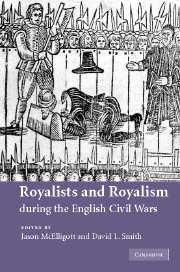Book contents
- Frontmatter
- Contents
- Notes on contributors
- Preface
- Abbreviations
- 1 Introduction: rethinking royalists and royalism
- 2 A lesson in loyalty: Charles I and the Short Parliament
- 3 The Court and the emergence of a royalist party
- 4 Varieties of royalism
- 5 Royalist reputations: the Cavalier ideal and the reality
- 6 Counsel and cabal in the king's party, 1642–1646
- 7 ‘I doe desire to be rightly vnderstood’: rhetorical strategies in the letters of Charles I
- 8 Royalists and the New Model Army in 1647: circumstance, principle and compromise
- 9 The royalist origins of the separation of powers
- 10 ‘A No-King, or a New’. Royalists and the succession, 1648–1649
- 11 The royalism of Andrew Marvell
- Subject Index
- Author Index
5 - Royalist reputations: the Cavalier ideal and the reality
Published online by Cambridge University Press: 19 July 2009
- Frontmatter
- Contents
- Notes on contributors
- Preface
- Abbreviations
- 1 Introduction: rethinking royalists and royalism
- 2 A lesson in loyalty: Charles I and the Short Parliament
- 3 The Court and the emergence of a royalist party
- 4 Varieties of royalism
- 5 Royalist reputations: the Cavalier ideal and the reality
- 6 Counsel and cabal in the king's party, 1642–1646
- 7 ‘I doe desire to be rightly vnderstood’: rhetorical strategies in the letters of Charles I
- 8 Royalists and the New Model Army in 1647: circumstance, principle and compromise
- 9 The royalist origins of the separation of powers
- 10 ‘A No-King, or a New’. Royalists and the succession, 1648–1649
- 11 The royalism of Andrew Marvell
- Subject Index
- Author Index
Summary
Charles I began the Civil War at a grave disadvantage. Forced to leave his capital by the tumults around his Whitehall palace, and the hostility of the City, he had been deprived of the machinery of government, and the power to raise revenue. He lost the means to defend the realm; his castles, ports, arsenals, the navy, the lieutenancy and the county militias. A further blow was that, because of the political crisis that eventually brought down his regime, he was saddled with the evil reputation of those who had rallied to his protection when he was least popular, the army officers of 1640, the swordsmen. Many, having served abroad, had returned to England to command in the two Scots' Wars. The failure of his attempts to put down the Scottish Covenanters turned the tide against his government, and placed a mighty weapon in the hands of his critics in the Long Parliament. The means which had been created to fight the Scots, however, the forces then raised, the officers commissioned and the networks formed, were to be used by both sides in the summer of 1642. The Somerset infantry regiment under Colonel Thomas Lunsford, raised in 1640, was recreated two years later. Even the issues which dominated in 1642 had been stated earlier. The famous rallying cry of Sir Bevill Grenville is often quoted as an instance of the basic loyalty of the king's supporters at the start of the Civil War: ‘I cannot contain myself within my doors when the King of England's standard waves in the field upon so just [an] occasion, the cause being such as must make all those that die in it little inferior to martyrs.’
- Type
- Chapter
- Information
- Royalists and Royalism during the English Civil Wars , pp. 89 - 111Publisher: Cambridge University PressPrint publication year: 2007



